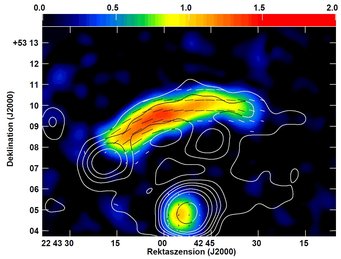Cosmic Magnetism
The origin of magnetic fields in the Universe is still a mystery in astrophysics.
Magnetic fields in nearby galaxies

The magnetic field traced by radio polarization observations forms nice spiral patterns in almost every galaxy, even in flocculent and irregular types which lack any optical spiral structure,but not in ellipticals. Spiral fields are also observed in the central regions of galaxies and in circum-nuclear rings of gas. In galaxies with massive spiral arms, the magnetic field lines are mostly parallel to the optical arms, but are concentrated at the inner edge of the spiral arms or between the spiral arms. In several galaxies, the field forms ''magnetic arms'' between the optical arms, in some they are crossing the spiral arms.
Polarized radio emission emerges from ordered fields, but the orientations of polarization "vectors'' are ambiguous by multiples of 180°. Measurements of Faraday rotation from multi-wavelength radio polarization observations allow determining the direction of the regular field component along the line of sight. Large-scale patterns of Faraday rotation angles observed in several spiral galaxies reveal regular fields with a constant direction, as predicted to be most easily excited by dynamo models. The field structures of some other galaxies can be described by a superposition of two or more dynamo modes. However, in many galaxies observed no clear patterns of the regular fields were found. Either galaxies are still too young to have a fully developed regular field pattern or a significant fraction of the spiral fields seen in polarization are anisotropic turbulent with frequent small-scale reversals due to shearing or compressing of isotropic turbulent fields.
Radio halos

The magnetic field orientations are mainly parallel to the disk near the plane, while vertical components are visible above and below the plane forming an X-shaped structure (see figure to the left). Sometimes the X-shaped magnetic field structure in the halo is accompanied by strong vertical fields above and below the central region of the disk. These observations support the idea of a ''galaxy wind'' which is driven by the energy of star formation processes in the disk and transports gas, magnetic fields and cosmic-ray particles into the halo. The speed of the outflow can be measured from radio observations and is of the order of 300 km/s.
Observations show that a number of spiral galaxies seen in edge-on view possess similar exponential scale heights in the radio continuum for the thin disk and for the halo even if they have different Hubble types and star formation rates and efficiencies. This similarity suggests the existence of a galactic wind in all of them, being part of a self-regulation mechanism between the galactic wind velocity, the total magnetic field strength and the star formation rate in the galactic disk.
Furthermore, a galactic wind is essential for effective dynamo action in the disk as it can transport small-scale magnetic fields from the disk into the halo and hence support the dynamo action in the disk. This effect may relate the efficiency of dynamo action to the star-formation rate in the galaxy disk. Mean-field dynamo models including outflows can also generate the “X-shaped” fields that are observed in edge-on galaxies.
Evolution of magnetic fields in galaxies

The origin of the first magnetic fields in the early Universe is still a mystery. A large-scale primordial field is hard to maintain in a galaxy because the galaxy rotates differentially, so that field lines would get strongly wound up during galaxy evolution, contrary to the observations. Small-scale "seed'' fields could originate from the epoch of cosmological structure formation, e.g. by the "Weibel instability" in shocks, or could have been injected by the first stars or jets generated by the first black holes, followed by a mechanism to amplify and organize the magnetic field. The most promising mechanism to sustain magnetic fields in the interstellar medium of galaxies is the dynamo. In young proto-galaxies without ordered rotation a small-scale dynamo amplified the seed fields within a few 10 million years. The mean-field dynamo in rotating galaxy disks generated large-scale regular fields within a few billion years. This scenario will be tested with the Square Kilometre Array (SKA) and its precursor telescopes.
Continuous injection of turbulent magnetic fields by the small-scale dynamo in turbulent flows in star-forming regions decelerates the growth of large-scale field modes and allows initial field reversals to persist. This may explain the large-scale field reversal observed in the Milky Way. If injection of small-sclae fields is restricted to spiral arms where the star formation mostly takes place, the large-scale field grows preferably in the interarm regions, as generally observed in spiral galaxies (see figure to the left).
Radio relics

Galaxy clusters are among the largest known structures in the Universe, extending over several megaparsecs. Galaxy clusters are filled with an intracluster medium, consisting of hot gas, magnetic fields, cosmic-ray particles, dark matter, and many interspersed galaxies. Most galaxy clusters are visible as extended radio sources that emit synchrotron radiation. As the magnetic fields in the intracluster medium are turbulent, the radio emission is mostly unpolarized, but with a prominent exception:
Huge streams of gas are continuously stirring the structures in the Universe. When a galaxy cluster collides with another cluster or an intergalactic gas cloud, a shock forms that compresses the gas and the magnetic fields and accelerates cosmic-ray particles. These shocks become visible as huge arcs in radio synchrotron emission, called “radio relics”. In more than 70 clusters relics were found so far, but probably many more exist that are too faint to be observed with present-day radio telescopes. Shock fronts amplify and order the turbulent magnetic fields of the intracluster medium, resulting in enhanced radio synchrotron emission with a high degree of linear polarization. Polarized radio waves are ideal to track relics.



